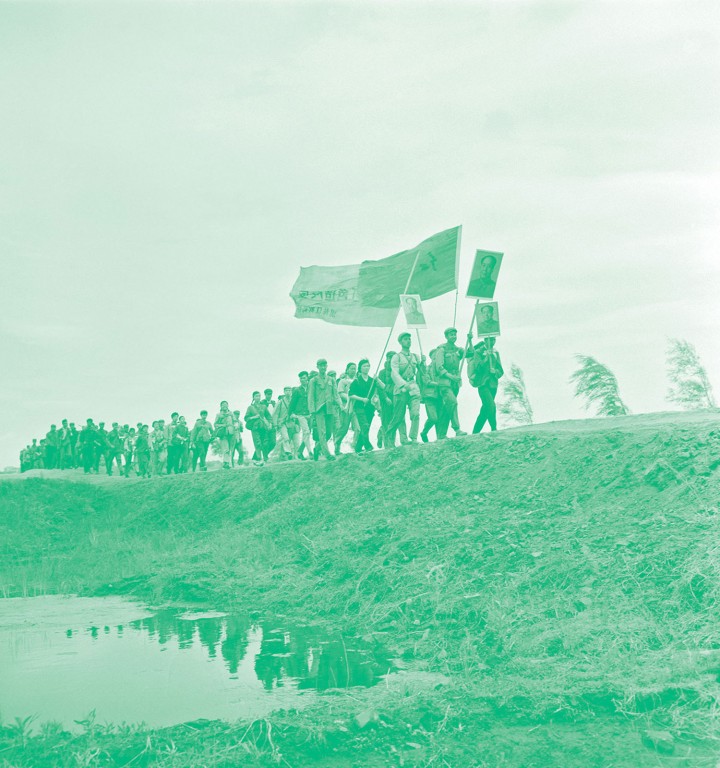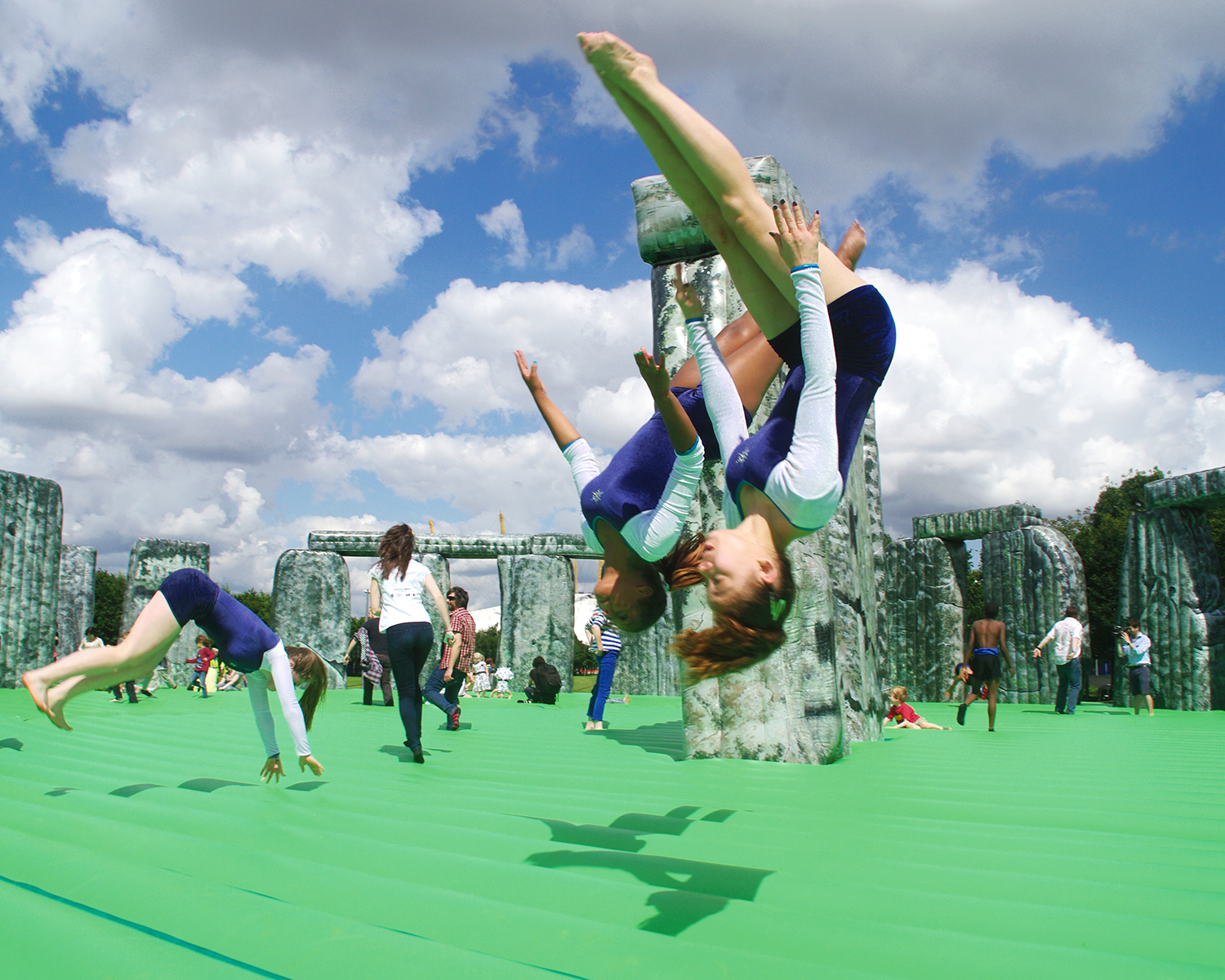
When the exhibition “Earth Works” was held at Dwan Gallery, New York, in 1968, it had been two years since the commencement of the Cultural Revolution. The genesis of Land Art brought piles of soil indoors in New York, pointing the consumerist world to an imaginary beyond; meanwhile in the “middle kingdom,” thousands of intellectuals were sent to rural regions as part of the “Down to the Countryside” (Shang Shan Xia Xiang) movement to release the libidinal pressure in the city after long school strikes. In the former, land was seen as a provocative gesture pointing to a conceptual nowhere in which temporal-spatial properties exceeded the size and durability of commodities (and their exchange system); in the latter, land was a plateau, a surrounding normality flattening the difference between intellectual labor and corporeal labor, rural and urban population. For the Cultural Revolution, land was the cultural and political “capital” for the Communist Party’s rise to power. In the propaganda of those harsh days, numerous posters with golden harvests under red suns pointed to another nowhere sundered by a utopian distance.
Contemporary art forms started to emerge after the revolution, like xiangtu xieshi (pastoral realist) paintings in the late 1970s and early 1980s, a shift from Socialist Realism to Rural Realism using a rustic aesthetic to depict pastoral life as a catharsis to the scars left on the land by the preceding political events. The equivalent of Land Art emerged around the early 1990s. Unlike the Western counterpart, Chinese Land Art did not necessarily take consumerism as a target, as consumerist society was still nascent. Neither was the work antagonistic to land’s impregnable banality and imagistic neutrality. Sometimes it even demonstrated a self-restrained attitude not unlike geological research, such as when artist Zhuang Hui created and photographed more than one hundred fifty-centimeter-deep holes (Longitude 109.88º E and Latitude 31.09º N, 1995–2008) at a number of spots along the Yangtze River, which would be flooded by the Three Gorges Dam, the largest reservoir project in the world. In a country with a huge peasant community, where earth is deified as a force of cultivation and protection, Land Art was privileged and camouflaged by the non-aggressive connotations of land. Some projects were even given a surprising green light from the government in the days when contemporary art was barely legal in China.

Chen Qiang’s Age Passes (1995) embedded 1093 containers filled with water sampled from the Yellow River in a monument praising the extensive hydro-engineering project that took place at the dawn of Chinese civilization. Additionally, Land Art gained acceptance by authorities who thought it could provide a boost in tourism. Di Naizhuang’s installation series zou hong (1992–1996), literally meaning “going red/going popular,” exhibited thousands of red umbrellas in public spaces in China, conquering parks in more than ten cities including Shanghai. It was a convenient copy of Christo and Jeanne-Claude’s umbrellas, with some “Chinese characteristics.” Support for the project from Chinese bureaucrats lead some to call it a “performance of the government.”
Rethinking Land Art — as happens with any institutionalized genre — is inevitable, especially in the era of the “anthropocene,” a term points to the modification of the earth’s surface by human activities — urbanization, desertization, mining, not to mention the visualization of the earth via the mechanical gaze of satellites — despite the current debate around it. The land as a nowhere — the Gaia’s empty box as an extension of the capitalist system — is transformed by the flow of its own image. When Google Earth can teleport us anywhere with a single click (though perhaps not to China, where this function is blocked), the vanishing nowhere appears to become closer, when in fact it has merely been “lumped together” with other objects by a uniform Heideggerian “distancelessness.” Timothy Morton’s concept of the “hyperobject” may offer an elaborate description of “land”: it is viscous, something that can never be shaken off; it is distributed widely in a temporal-spatial way; it is both transdimensional and non-local. Land as a hyperobject may transform Land Art’s battle with the consumerist world — not with its rawness and remoteness but through all of the aforementioned properties. Yet we don’t know who will have the last laugh, as capital is also a hyperobject, and the temporal-spatial elongation of “land,” which once transcended the consumerist system, may be dissolved by the accelerationist horizon of capital, where the future is no longer produced but instead becomes the apocalyptic end of a long present.

The new political understanding of land in China gives rise to another type of quasi-Land Art that does not directly assault the system but surfs along it, revealing the power vectors that are inscribed upon land as objects and concepts, using land-based systems to open up new regions previously unknown by those systems. Despite the explosion of the real estate market in China, land privatization is impossible; land ownership means a lease between the people and the government for not more than seventy years. Land is scarce in China like anywhere else, but the rights of use, occupation and operation, and the transferability of those rights and their restrictions (for example, changing the use of farmland is difficult) weave a tapestry that surpasses the area of the land itself.
In 1993, Chinese artist Wang Jianwei went back to the village where he spent his days during the “Down to the Countryside” movement. He provided farmers with the seeds of an advanced breed of wheat, forming a contract in which the artist would share the harvest. The outcome was a satisfactory harvest that accrued the artist fifty kilograms of wheat — after the peasants gave a certain share to the government. The project, Circulation: Sowing and Harvesting (1993–94), appropriated the post-People’s Commune contract system, wherein peasants are allowed to manage their land (owned by the Party-State) and participate in the market with their surplus crop. Orchestrated by the growth cycle of the crop, the artwork serves as an experimental field for visualizing agricultural labor and the land as a physical platform. It stages a miniature cycle steered by an invisible hand after the era of China’s semi-planned economy.

The land does not only reveal socio-economic relationships linked to agricultural production; it also explicates the socio-geological strata of urban planning in which nature is meant to be a controllable factor. Xu Tan has conducted field research in the Pearl River Delta (which just surpassed Tokyo as the world’s largest urban area) on the socio-political properties of vegetation. Local and primitive species in this area faced a cultural slash-and-burn in the name of functionality and manageability. Tropical exuberance in public spaces was replaced by botanical choices that are easier to govern and maintain. In Two Square Meters of Land (2013–ongoing), Xu Tan signed a century-long contract, longer than any legal lease in China, with his gallery Vitamin Creative Space, in which he leased a two-square-meter piece of land in Panyu, Guangzhou, from the latter party. The contract prohibits any human activities on the site. The project suggests a retrospective post-Internet mindset that seeks to unmark human traces from the land, to transform it back to a geological tabula rasa disentangled from physical and legal interventions. Xu’s interrogation of land and his research on vegetation can be seen in the exhibition “Question, Soil and Socio-Botanic” of 2013, which showed the thin line between agriculture and economic activity. His detailed research reveals neglected facts, like how farmers in Panyu have to compete for farmland with the nouveau riche who wish to purchase a pastoral lifestyle. Although pursuing similar activities — sowing, plowing, reaping — the peasants aim to produce daily food and cash crops, while the nouveau riche are driven by the symbolic value of such activities. Even if the use of the land remains physically and legally unchanged, the legitimacy of occupying farmland is questioned, as is the legal status of the “farmer” in China. Such human relationships with plants not only create class conflict.
They also create zones that are spatialized by human activities. Chu Yun’s Love (2005) was a response to an invitation by Siemens VDO to produce an art project at their base in Huizhou, Guangdong. The automobile electronics firm demarcates its spaces based on functionality — either human or machine. There are zones for living, producing and administrating. Trees are planted as a zoning tool for optimizing work environments according to quantified performance analysis. The factory employs a precise amount of controllable natural elements within the enclosed work area. Chu’s project is to plant another tree next to every existing one. Almost everything paired, from bird to coconut, is a romantic symbol in Chinese tradition. Chu Yun reframes this cliché — a burned-out, low-performance semantic redundancy — as an affective, unfavorable factor that encumbers a production line managed “seamlessly” by automatically supervised assembly line workers, who in turn become part of the production chain. Unlike Beuys’s 7000 Oaks, which shaped public space as a social sculpture, Chu’s foliage generates a suspension, a mild intervention that glides across the surface of mechanized alienation.

While Chu and Xu’s projects reflect a land haunted by ontological and socio-political vectors, Zheng Guogu delves into legal gray areas. In 2005 he bought a piece of land in his home of Yangjiang, which has now expanded to more than forty thousand square meters. In short, his ongoing project, Age of the Empire (now renamed Liao Yuan or “Accomplished Garden”), is transforming the area according to the titular real-time strategy game played by millions of gamers in China. An amateur architect, Zheng builds roads, plants trees, constructs museums with circular windows and even moves tons of rocks. These all echo aspects of the game, which presents the growth of civilization without bureaucratic and physical elements. Curiosity has grown as the project has evolved, yet the most compelling part of it is the power struggles between government bureaus and their evolving definitions of land as manifested by law. Violations of building codes, including illegitimate changes to land use (difficult to define in this case), pervade the Age of the Empire. Tenuously legal, the artist’s social networks, negotiations and fine payments keep the project running. The land becomes an accumulation of traces in the process of reshaping the apparatus of governance, thus opening up the virgin territory of the juridical system through the materiality of land. The “empire” here is built on a sovereignty of exceptions borrowed from legal doctrine. Zhang Liaoyuan is carrying out a similar experiment in 1m2 (2006). Here a piece of road measuring one square meter, the basic unit of private property, is cut out from the busiest intersection on Yanan Lu, one of the main axes of Hangzhou. This act, which has no legitimate motivation according to society, was realized after long negotiations between the local government and real estate developers. Liu Wei and Chen Haoyu’s Propitation (2007) demonstrates a similar logic: shapes are cut out from the road in 798, a core art district in Beijing and a tourist attraction. These artworks are reminiscent of Liu Wei’s “trademark” stamp “Property of L.W.” that can be found on concrete blocks (including works presented as a light box in Discovery No.1, 2006). In this case the material that constructs public and private space, on land owned by the Party-State, is appropriated so as to replace the impossibility of privatization with artist’s ownership through authorship.
In a post-manifesto era too far away from 1968, these quasi-Land Art works are not the consequence of a conceptual consensus, nor even a consistent practice among particular artists. Yet they pave the way for remapping the land — as an object and as a concept — destabilizing its conception as a political absolute. They foster a rethinking of collectiveness through a material plane that people share, generating fissures that can release yet unknown properties of the land.





